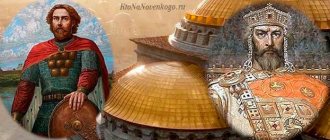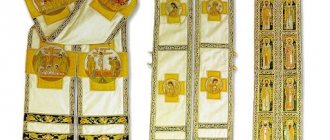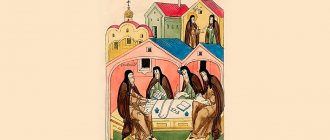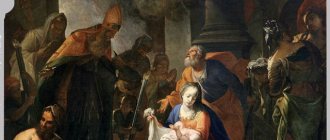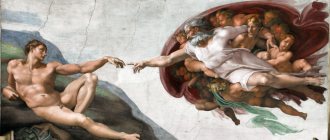The emergence of the first religious beliefs is comparable, perhaps, with the appearance of Homo sapiens, who had the ability to think abstractly. In this article we will understand what religion is and how it influences people's behavior.
Unable to explain the essence of natural and social processes rationally, the first people created their own distorted, fantastic models of the universe. These ideas developed and strengthened in unison with humanity itself, acquiring rituals, cults, dogmas, and sacraments. From generation to generation they took root in people's minds, becoming increasingly important.
The modern world can no longer be imagined without religion. Regardless of an individual’s attitude to faith, religion has become deeply embedded in culture, absorbed into consciousness, becoming part of the mentality, a marker in determining the identity of the people.
What is religion? Brief definition of this concept
What is the reason for the popularity of religious beliefs and their centuries-old immortality? The fact is that religion serves a person as consolation and protection. If in ancient times it was protection from aggressive natural elements, then now, religion is an opportunity to hide from social injustices, insults inflicted by society itself.
In short, unlike esotericism, religion is something that approximately studies the inner world of a person. It gives some answers to the questions: what is faith, soul, God, love. Just like esotericism, religion considers spiritual issues. The questions are essentially the same, but the filling is completely different. In addition, religion and esotericism establish and reflect norms, orders, values, and form models of human behavior. Thus promoting their ideological integration. Gives you the opportunity to feel that you belong to a particular world.
Performing the function of uniting peoples under its leadership, religion also acts as a powerful regulatory lever. Not just falling in line with the political and cultural organization of states, but often determining the direction of their development.
What is religion based on? Religion is based on belief in God. A person accepts, believes and turns to God. Believer:
- Tries not to lie;
- Don't steal;
- No need to express himself, he has a clear conscience;
- He feels a surge of strength, energy, his feelings open up.
Religion has faith and spiritual laws. But practically, there is no feedback - a person does not have a direct vision and absolute understanding of what is happening, how everything works.
Functions of religion
Almost every religion exists not only in the form of a worldview, but also in the form of an organization (church) conducting religious activities. A church is an organization that transmits religious values and unites believers. The concept of church is inseparable from the concept of church sacraments, rituals and rules. They can exist as a direct prescription of the text of the doctrine (the sacrament of the Eucharist (communion) in Christianity is described in the New Testament), or they can be a product of church practice. For example, nowhere in the Bible will we find an injunction to confess. The New Testament contains the idea of repentance, and the idea of confession (as one of the forms of repentance) was born within the Christian church.
In religion, in church, people find ideas and meanings that are important to them. Sometimes faith and church become a person’s way of life (monks, clergy, etc.)
In other words, the church satisfies a number of people’s needs, which allows us to talk about the functions of religion :
- Comforting
- Communicative
- Solving existential questions (every person at some point in life thinks about death, loneliness, the meaning of life, and these questions are at the core of religions)
- Regulatory
- Worldview
The Reason Why Religion Makes Our Lives Better
There is a widespread belief that religion, belief in God, makes people weak, ignorant and backward. You might think that if a person is an atheist, then he is immediately so strong, smart and advanced.
Vyacheslav Butusov, Anton Makarsky, Mel Gibson are deeply religious personalities, like many celebrities. So, religion does not hinder success in life at all?
The scientific paradigm of thinking assures us that a person is alone in this world and must rely only on himself. Depressing thought. Maybe that’s why non-believers are such cynics.
Origins of Wicca
This young religion gained popularity in 1954, thanks to its apostle, occultist and magician Gerald Gardner. According to the legend that he told the world, he was initiated into the secrets of ancient pagan teachings by members of an underground witchcraft cult that survived in Europe. This tradition, according to Gardner, is a direct descendant of pre-Christian European beliefs based on the veneration of the forces of nature, personified in the image of the Mother Goddess and God the Father. From the point of view of history, archeology and anthropology, these statements are rather dubious, so it is officially believed that the Wicca religion was founded no earlier than the 20s of the 20th century. It indeed reflects some features of archaic matriarchal beliefs, but by its nature it is rather an attempt to carry out their partial reconstruction with subsequent synthesis based on the concepts of modern neo-paganism. Thus, the theory of direct inheritance is not supported by serious scientific arguments.
An immediate correction must be made regarding the question of who created the religion of Wicca. This word originally referred to the tradition of Gardner's opponent, Charles Cardell, while Gardnerian teaching was simply called "witchcraft." However, since the 60s, the name “Wiccans” began to be applied to the followers of Gardner, and subsequently to all other similar and derivative traditions. Thus, it can be argued that today the name religion “Wicca” means several more or less similar religious and magical movements. Below we will not touch upon the originality and characteristics of each of them, since there are a lot of them, and new forms of Wiccan theory and practice are constantly being created. Plus, a good half of Wiccan adepts are, by their own statements, eclectics, successfully combining not only elements of various intra-Wiccan divisions, but also combining them with other religions, thanks to which the so-called Christian, Jewish and even Muslim Wicca exist in the world. Instead, we will talk about common religious tenets, worldviews, and points of intersection in the practices of adherents of various Wiccan denominations.
Only God knows the truth
What arguments can be made in favor of religion?
In the atheistic world, the principle of moral indifference reigns. “There is no absolute truth, everyone has their own point of view, and they are all correct in their own way.” A strange conclusion, glorifying human blindness and limitations.
There can only be one truth, and if everyone follows their own line, then it is more correct to say that both are mistaken. But they are afraid to admit that they do not understand the essence of things, because then they will have to believe that we are responsible before God. It is much more pleasant to think that each of us is an idol who keeps his life under control.
But if there is absolute truth, then only a supreme being who sees everything, lives outside of time and is much smarter than man can know it. That is God.
Religion makes the state and the person strong
Actually, because of debauchery and “sin,” many well-known successful civilizations perished, and today many Western countries also suffer greatly from the onset of this disease, so Christians decided and initially determined for themselves what a “correct” family should look like, the creation of which will help to avoid society of the main possible problems.
And that is why the Christian world with similar ideas survived and turned out to be stronger and more civilized than almost all surrounding nations.
Why do women have less willpower?
By the way, this story also hints at the fact that a woman has less willpower and is more difficult to resist animal instincts, I hope you yourself have already guessed for what reason.
And it is, as always, banal, it’s just that women do not evolve so quickly, since their genes are not so variable, and nature quickly changes mainly the genes of men, and wise women themselves select mostly more conscious men, and among men natural selection often occurs according to this sign.
Therefore, thanks to the greater development of logic and reason, a man can more easily suppress animal desires in himself, but a woman also has her own advantage in the form of natural intuition, and this advantage can be used as intelligently as possible precisely when it is subordinated to the male mind within the framework of a normal human family.
But female intuition without logic and obedience is very dangerous, and that is why the Catholic Church, at one time, tried with all its might to pacify the character of women, burning the most rebellious and bitchy women - “witches” at the stake, so that others would behave more restrained and humbly.
And also, therefore, many priests observe a vow of celibacy (so as not to be subordinate to a woman within the family and not subject to her influence) and do not allow women to occupy high positions in the church.
Well, this is not all that a correct religion can teach and educate, and how it makes modern society stronger and more intelligent, so in the next article read the continuation about what the real strength and benefit of Christianity is for educating a person and what exactly it can do teach a successful individual and society as a whole.
Rituals
There are no universally accepted Wiccan rituals - each Wiccan or Wiccan coven creates their own rituals based on personal tastes, views and preferences. The only thing that can be said is what some Wiccan ceremonies are dedicated to. Firstly, these are sabbats and esbats, which will be discussed below. Secondly, these are practices of initiation or self-initiation into the tradition. The most conservative covens adhere to a three-part initiation system. Thirdly, there are rituals of Wiccaning and handfasting. The first of these is a ceremony in which the newborn is presented to the God and Goddess in order to ensure the baby's protection. Wiccaning is not initiation into a religion, and therefore is not analogous to baptism in Christianity. Handfasting is a Wiccan marriage ritual. This is all that can be said about this, because each Wiccan keeps specific descriptions of rituals secret, trusting them only in his personal book of shadows - a collection of spells, ceremonies and similar information.
The core witchcraft traditions of Wicca have their roots in ancient rituals of the agricultural cycle. In more specific matters, magic is based on the ideas of European witchcraft: the four elements, by manipulating which a witch or sorcerer produces the desired changes in the physical world. This distinguishes Western and Northern magic from Eastern magic, where the magician only summoned the spirit he needed, who did all the necessary work. However, as already mentioned, the Wicca religion often takes on an eclectic character in the person of its followers, who actively experiment with various traditions, including African, Australian, Native American, Tibetan and shamanic practices. The fundamental basis of any magical work in this system is the postulate about the four elements, known from the writings of the classics (fire, earth, water, air) and about the spirit. The elements can be controlled by willpower, causing the desired changes on both the physical and mental levels. This is magic. Wicca is ambivalent about the differentiation of magic into black and white, although many authorities of the movement previously adhered to this division. At the same time, the very attribution of the color black to evil is denied. But Wiccans still have not developed a more or less intelligible concept about what evil is. However, they have their own moral values, which will be discussed below.
Wicca religion in Russia
As we know, everything comes to our country late. And if in the USA the Wiccan symbol was included in the official list of emblems of religions back in 1985, then in Russia Wicca is just beginning to develop. So, our first coven appeared only in 2011 in Udmurtia. However, this was the first official registration of the Wiccan community. Its adherents, of course, existed before, but in very limited numbers. Today, thanks to the Internet and cultural trends, Wicca in Russia is developing quite quickly, mainly due to young people. At the moment there is a Union of Wiccans of Russia, and there are several other organized Moscow and St. Petersburg groups. The number of covens is growing rapidly, and even more - the number of solo practitioners. Among other things, there are already splits and confrontations between them on various issues, which in itself speaks of the significant influence and relative number of representatives of Wicca in Russia.
Buddhism
Buddhism has long been a popular religion in East Asia. Translated into Russian from Sanskrit, this word means “the teaching of spiritual awakening.” Its founder is considered to be Prince Siddhartha Gautama, who lived in India in the sixth century BC. The term “Buddhism” appeared only in the nineteenth century, but the Hindus themselves called it “dharma” or “Boddhidharma”.
Today it is one of the three world religions, which is considered the most ancient of them. Buddhism permeates the cultures of the peoples of East Asia, so it is possible to understand the Chinese, Hindus, Tibetans and many others only after becoming familiar with the basics of this religion.
The main ideas of Buddhism are the following: - life is suffering; - suffering (dissatisfaction) has a reason; - there is an opportunity to get rid of suffering; - there is a way to deliverance.
These postulates are called the four noble truths. And the path that leads to getting rid of dissatisfaction and frustration is called “Eightfold”. It is believed that the Buddha came to these conclusions after seeing the troubles of the world and sitting for many years under a tree in meditation on the question of why people suffer.
Today this belief is considered a philosophical movement, not a religion. The reasons for this are the following: - in Buddhism there is no concept of god, soul and redemption; — there is no organization, uniform dogmas and unconditional devotion to the idea; — its adherents believe that there are an infinite number of worlds; - besides this, you can belong to any religion and be guided by the principles of Buddhism, this is not prohibited here.
Symbolism
Wiccans adopted many ancient symbols from a variety of cultures. However, there are the most characteristic and, so to speak, official signs that distinguish, for example, Wiccan tombstones. The first is a straight pentagram, meaning the harmony of the elements under the leadership of the spirit. The second is the lunar symbol, which represents the Goddess. Wicca uses the ancient Greek standard for this purpose. This is how, for example, the Greek lunar goddesses were depicted. Also represents the Great Mother and Wicca. A photo of this sign is given below.
Zoroastrianism
As we mentioned at the beginning, the religion of ancient people attributed powerful properties to various elements and objects. This belief was preserved by the ancient Persians. Neighboring peoples called them “fire worshipers”, as they especially revered this phenomenon.
This is one of the first world religions that had its own Holy Scripture. This did not happen either in Sumer or in Egypt. There were only scattered books of spells and hymns, myths and recommendations for mummification. In Egypt, it is true, there was a book of the dead, but it cannot be called Scripture.
In Zoroastrianism there is a prophet - Zoroaster. He received the scripture (Avesta) from the supreme god Ahura Mazda.
The basis of this religion is freedom of moral choice. Man fluctuates every second between evil (personified by Angro Manyu or Ahriman) and good (Ahura Mazda or Hormuz). The Zoroastrians called their religion “Good Faith” and called themselves “believers.”
The ancient Persians believed that man was given reason and conscience in order to correctly determine his side in the spiritual world. The main tenets were helping others and supporting those in need. The main prohibitions are violence, robbery and theft. The goal of any Zoroastrian was to achieve good thoughts, words and deeds at the same time.
Like many other ancient religions of the East, the “Good Faith” ultimately proclaimed the victory of good over evil. But Zoroastrianism is the first creed in which such concepts as heaven and hell are found.
They were called fire worshipers for the special reverence they showed to fire. But this element was considered the crudest manifestation of Ahura Mazda. The faithful considered sunlight to be the main symbol of the supreme god in our world.
Holidays
Wicca is unthinkable without its traditional eight holidays. All of them have ancient pre-Christian origins and are focused on the change of seasons in their connection with agricultural work. The calendar of these dates is called the wheel of the year in Wicca.
Of the eight holidays, four are considered great. They are identical to the ancient Celtic celebrations and signify the changing of the seasons. Another four are the days of the spring and autumn equinox, as well as the winter and summer solstices. All eight are called sabbaths. Here they are: Samhain, Yule, Imbolc, Ostara, Beltane, Lytha, Lammas and Mabon.
In addition to them, there is also the concept of “esbat”. The latter represent full moons and sometimes new moons, which are also considered special holiday times.
Ancient Egypt
Egypt became the successor to the religion of the ancient civilizations of Sumer. His priests were able to continue the work of the Babylonian priests. They developed sciences such as arithmetic, geometry, and astronomy. Stunning examples of spells, hymns, and sacred architecture were also created. The tradition of posthumous mummification of noble people and pharaohs has become unique.
The rulers of this period of history begin to proclaim themselves the sons of the gods and, in fact, the inhabitants of heaven themselves. It is on the basis of this worldview that the next stage of the religion of the ancient world is built. A tablet from the Babylonian palace speaks of the ruler's initiation received from Marduk. The texts of the pyramids illustrate not only the chosenness of the pharaohs by God, but also show a direct family connection.
However, such veneration of the pharaohs was not from the very beginning. It appeared only after the conquest of the surrounding lands and the creation of a strong state with a powerful army. Before this, there was a pantheon of gods, which subsequently changed a little, but retained its main features.
So, as stated in Herodotus’s work “History”, the religion of the ancient Egyptians included rituals dedicated to different seasons, the worship of deities and special rituals designed to strengthen the country’s position in the world.
Egyptian myths tell of the goddess of the sky and the god of the earth, who gave birth to everything that surrounds us. These people believed that the sky was Nut, standing above Geb, the god of the earth. She touches him only with the tips of her fingers and toes. Every evening she eats the sun, and every morning she gives birth to him again.
The main deity in the early period of Ancient Egypt was Ra, the sun god. Later he lost the championship to Osiris.
The legend of Isis, Osiris and Horus later formed the basis of many myths about the murdered and resurrected savior.
Sumerian-Akkadian civilization
Next we will consider some ancient religions of the East. Why do we start with them? Because the first civilizations arose in this territory. So, according to archaeologists, the oldest settlements are found within the “fertile crescent”. These are lands belonging to the Middle East and Mesopotamia. It is here that the states of Sumer and Akkad arise. We will talk about their beliefs further.
The religion of ancient Mesopotamia is known to us from archaeological finds on the territory of modern Iraq. Some literary monuments of that period have also been preserved. For example, the tale of Gilgamesh.
A similar epic was recorded on clay tablets. They were found in ancient temples and palaces and later deciphered. So, what do we know from them? The most ancient myth tells about the old gods who personify water, sun, moon and earth. They gave birth to young heroes who began to make noise. For this, the originals decided to get rid of them. But the sky god Ea figured out the insidious plan and was able to put his father Abuz to sleep, who became the ocean.
The second myth tells of the rise of Marduk. It was written, apparently, during the subjugation of the remaining city-states by Babylon. After all, it was Marduk who was the supreme deity and guardian of this city.
The legend says that Tiamat (primary chaos) decided to attack the “heavenly” gods and destroy them. She won several battles and the originals became “despondent.” In the end, they decided to send Marduk to fight Tiamat, who successfully completed the task. He chopped up the body of the defeated woman. From its different parts he made the sky, the earth, Mount Ararat, the Tigris and Euphrates rivers.
Thus, Sumerian-Akkadian beliefs become the first step towards the formation of an institution of religion, when the latter becomes an important part of the state.
Ethics
Wicca, as stated above, does not have any sacred, inspired scriptures. However, there are texts that are more or less authoritative for its adherents, among which is a simple but succinct rule: “If your actions do not harm anyone, then do what you want.” This slogan serves as a guide in life that every witch uses. Wicca, however, does not have a definitive teaching about who and what is included in the circle of these “nobodies.” Does it include only people or animals, including insects? What about the plants? Or how can a Wiccan called to war cope with this attitude? Is this restriction lifted if self-defense is necessary? And is revenge acceptable? There is no clear answer to these questions. But there is another quite popular text called the Testament of the Goddess. It was written by Doreen Valienti and talks about eight qualities that a witch should strive for: joy, honor, respect, humanity, strength, beauty, power and compassion.
The third very popular moral principle of Wiccans is the so-called law of threefold retribution, according to which whatever a person does will be returned to him threefold. Thus, the actions of a Wiccan are determined not by the commandments of the deities, but by what in Christianity is called the golden rule: “do not do to others what you do not wish for yourself.”



